All About the Flat Tops Wilderness
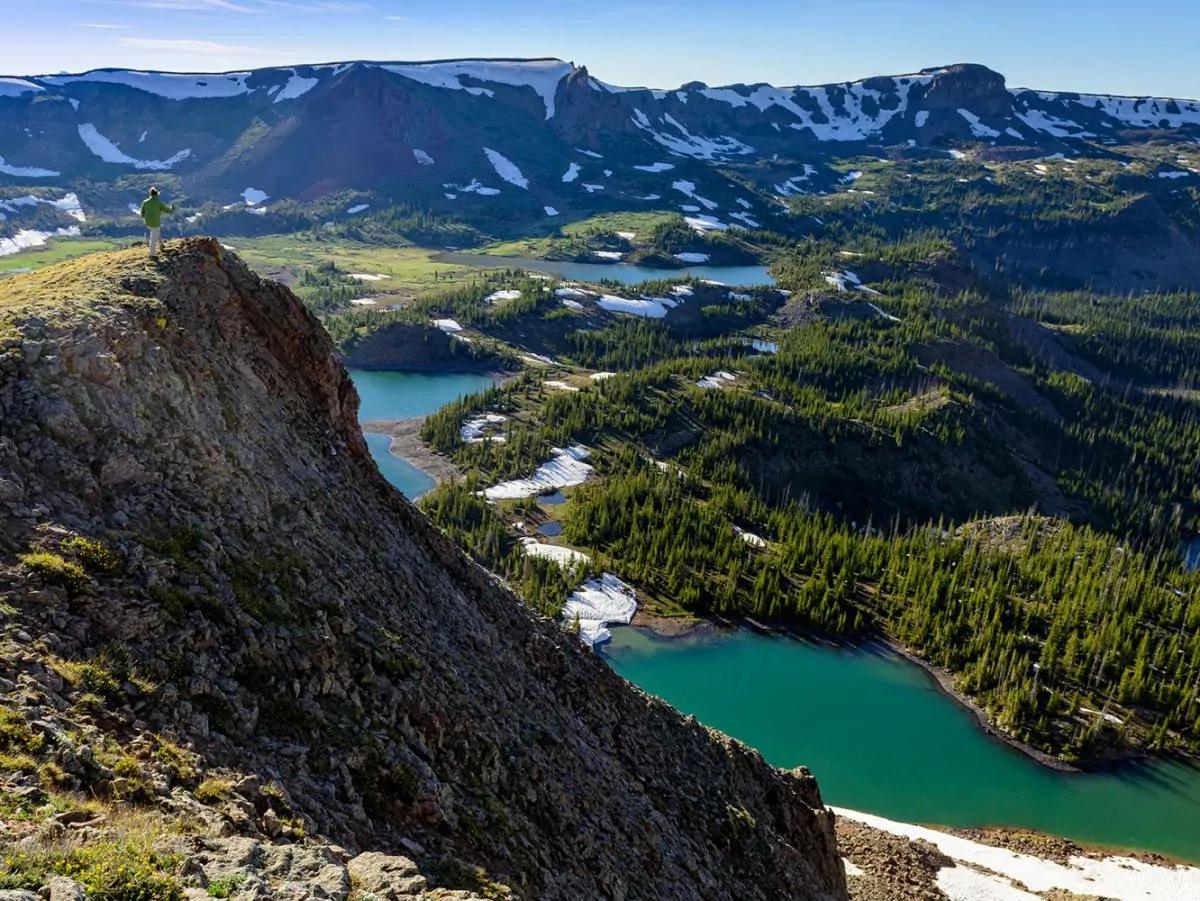
Colorado is famous for its stunning mountain landscapes — many people know of the splendor of Rocky Mountain National Park. However, one of Colorado’s lesser-known gems is also one of its most spectacular. The Flat Tops Wilderness offers some of the most remote and biologically rich backcountry travel in the Rockies. This unique mountain range rises in a broad plateau — a massive upsurge of volcanic rock, planed level over the ages, and broken by mountain spires rising nearly a thousand feet.
A still relatively undiscovered gem, the Flat Tops provide great hiking, adventurous backpacking, and plenty of solitude. You’ll explore elevations from 7,600 to almost 13,000 feet, large subalpine meadows, and forests of aspen, spruce, and fir. This high-elevation but gentle landscape offers many diverse routes for one-of-a-kind trekking experiences.
When you visit the Flat Tops Wilderness, you may witness elk, deer, mountain lion, mink, ptarmigan, marmot, and moose wandering the high landscape. In the summer, an array of wildflowers, from columbine to Parry Primrose, carpet the extensive subalpine meadows of the plateau. To top it all off, this region is lush with running water. This is a land of alpine lakes and quiet ponds, with over 110 glacially-carved bodies of water gracing the broad valleys below the Flat Top Plateau. This expansive wilderness is a land of flowing rivers, over 100 miles of them, with trout abundant in both.
Quick Facts:
- Size: 235,214 Acres
- Human History: circa 8500 years
- Designated a Wilderness: 1975
Geology
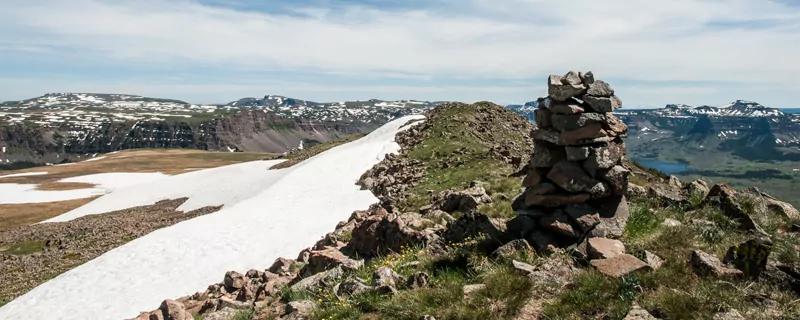
This area, which is part of the White River Plateau, began to form about 52 million years ago. Tectonic forces created swirling pockets of magma under the ground, which forced the earth itself to rise. Subsequent volcanic eruptions coated the newly formed mountains with basalt, giving them their iconically-flat appearance. A series of ice ages then carved out the valleys and cirques, grinding the land into its current majesty. As a result, the Flat Tops are like no other mountain landscape in the country. Be sure to visit these must-see sites that show off Flat Tops’ unique geology and what makes it so special.
Chinese Wall
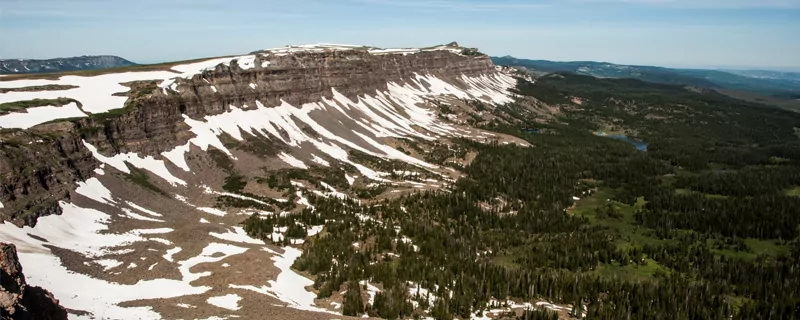
As a glacier slides slowly downhill, it forms a moraine – a natural dam of debris the glacier had carved and pushed before it. Moraines form at both the glacier’s terminus and along its sides. As the glacier carves away the mountain basin, it leaves a cirque: the sheer, steep, circular cliff formed by the force of the glacier pushing its mass downhill. The Chinese Wall in Flat Tops Wilderness is a stunning example of this geologic process.
The Chinese Wall Trail, a 17.5-mile thru-hike, traverses the length of this majestic mountain feature. The trailhead is about 45 miles east of Meeker, CO. It begins about half a mile from the Ripple Creek Pass summit. You’ll be hiking at elevations nearing 12,000′ and at times it feels as though you are trekking through some kingdom in the sky. The vistas from this trail are unending and it is truly enjoyable alpine hiking. The rolling terrain is a challenge and the scale is vast. Come prepared to spend a night (or two) in high-elevation conditions.
Devil’s Causeway
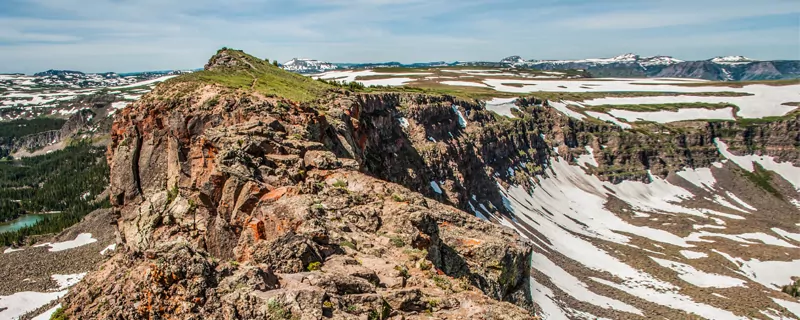
When two cirques meet, they form an arete: a sharp, narrow, mountain ridge. The Devil’s Causeway an example of this phenomenon. At times only three feet wide, its sheer cliffs drop away on both sides 600 to 800 feet to the valley floor below. If you’re scared of heights, you’ll do some rock hugging as you scramble over this rocky and uneven narrow section. You can reach the Causeway via the Chinese Wall Trail, or by coming up from Stillwater Reservoir via the East Fork Trail.
Though the narrow section may have your heart in your throat, it’s the 360-degree views that will leave you breathless.
Kettle Lakes
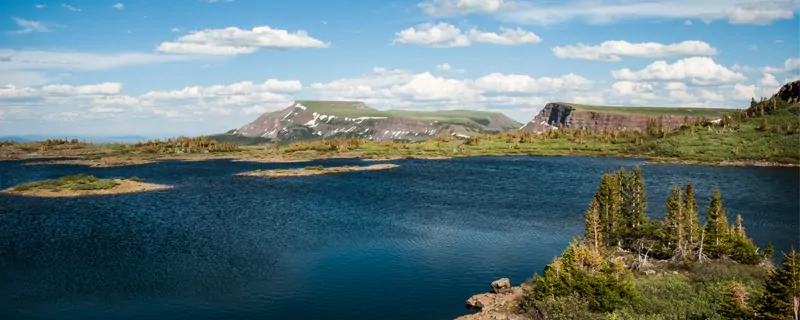
Kettle lakes aren’t a place, but a geologic feature.
As a glacier melts and recedes, blocks of ice break off and plant themselves where they land. As the glacier continues to melt, it partially buries these ice blocks in debris via an outwash plain (essentially debris being washed out of the glacier by meltwater). When the isolated ice blocks finally melt, they leave behind a water-filled depression known as a kettle lake.
Little Causeway Lake, an example of a kettle lake, showcases the area’s glacial past. About a mile and a half hike from the East Fork trailhead, Little Causeway is often a resting spot for those making the trek up to the Devil’s Causeway.
Hike Flat Tops Wilderness with a Guide
To see the best of the geologic wonders of this region, check out our Flat Tops Explorer trek — a more challenging and intensely scenic experience in Colorado’s deep backcountry. This five-day trip ascends a breath-taking, glacially-scoured valley, through meadow and forest habitats, and into lake-strewn high country. Then, we climb Big Marvine Peak and explore as we want; gentle mountain ascents and side trips to remote, unnamed lakes. We see the effects of fire and ice on the landscape as we walk: glaciers and volcanoes have shaped the landscape of the Flat Tops Wilderness. Join us for one of the more magnificent and wild journeys in the Rocky Mountains!
Wildland Trekking handles permits, gear, transportation, meals, and provides a professional guide so you can focus 100% on enjoying your adventure.
History
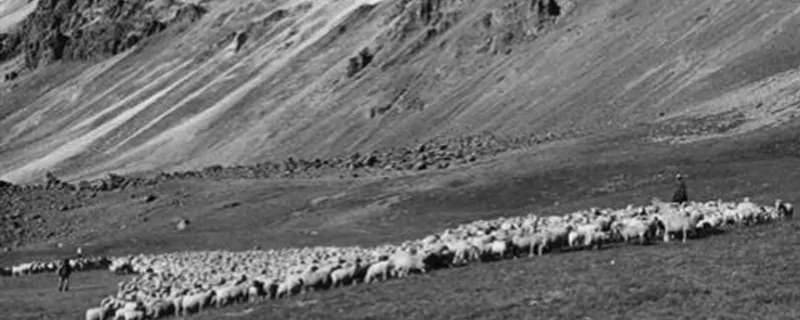
The Flat Tops region has a long and occasionally tumultuous history. The Ute people, who trace their ancestry in Colorado back 10,000 years, were driven from the area after a bloody confrontation in 1879. Then, the region became the focal point of a statewide debate over who had grazing rights to the land.
While this region has a flawed past, the land itself inspired the Wilderness Act of 1964, and the idea for “an area where the earth and its community of life are untrammeled by man, where man himself is a visitor who does not remain.”
In 1919, Arthur Carhart visited the area to survey it as a potential site for summer home development. He was so struck by the landscape that he informed his superiors the land should be set aside, protected, and preserved for generations. He spoke passionately about the subject, and he (and thus, the Flat Tops) are credited with sparking the ideas fundamental to the Wilderness Act of 1964.
The Ute
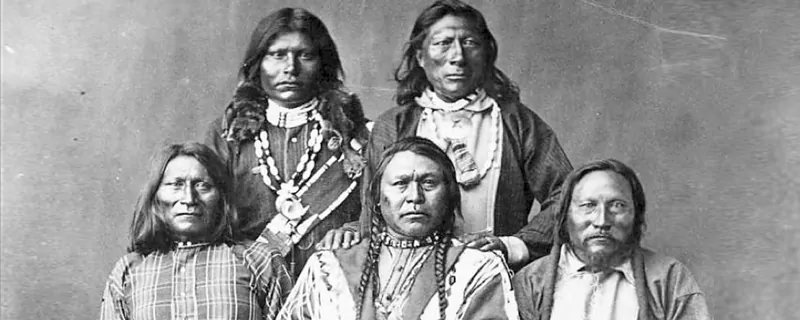
All throughout human history, the story of humanity is the story of migration. Typically, a group does not remain in an area for more than 1,000 years. The Ute people, however, can trace their ancestry in Colorado back 10,000 years. Today, it is incredibly rare for a group of people to have roots that extend that deep for a place. For example, the Navajo have occupied their iconic four-corners region for centuries, but their ancestors migrated from more northern locales.
The Ute tribe has lived on the land now known as Colorado (along with parts of Utah, Arizona, New Mexico, and Wyoming) since time immemorial. On the land that is now the Flat Tops Wilderness, the Ute developed a language and a distinct culture that has lasted over 10,000 years.
However, by the late 1800s, American settlers began to undermine the Utes’ ability to remain on their land. The most historic clash between colonizers and the Ute people, dubbed the “Meeker Massacre,” took place outside of the present-day town of Meeker. Euro-American colonizers forcibly removed the Ute from the resource-rich region. They placed members of the indigenous tribe on arid strips of land in Utah and Southern Colorado. Today, many of their descendants still reside on these reservations. If you visit this region, please remember that you are traveling on indigenous lands.
Sheep Wars
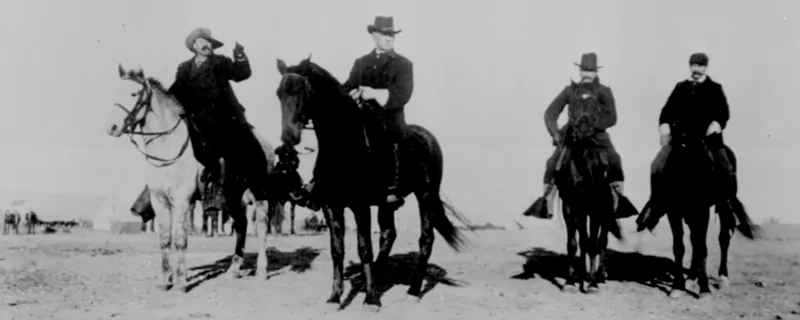
In the late 1800s, a fierce debate raged across Colorado regarding who had “natural” rights to grazing on the public lands of Western Colorado. Cattlemen were the first to begin grazing animals in the area, so they were wholly against what they saw as an “invasion” of sheep herds onto “their” land. The debate got ugly, and it became increasingly about race instead of livestock. Cattle ranchers began committing racially-motivated acts of violence against Hispanic sheepherders. In the San Luis Valley, families were threatened assaulted, or killed.
In the Flat Tops area near the town of Craig, a man named George Woolley lost his entire herd to the debate. Woolley, a former cattleman, decided to instead raise sheep. The decision rankled local cattleman and while George was off in Denver for business, a group of men clubbed his herd to death.
The violent act made the papers. Some citizens began to express sympathy towards the sheep farmers who, to that point, had gotten little. Sheep populations in the area continued to grow, as did animosities. In 1920, the Colorado militia had to be called in to quell the “Battle of Yellowjacket Pass” – a skirmish that took place between the towns of Craig and Meeker.
Eventually, the Taylor Grazing Service was created to oversee grazing on public lands. Today, many sheep farmers still graze their flock here today and you may run into some sheep while hiking the high country in summer.
Trapper’s Lake
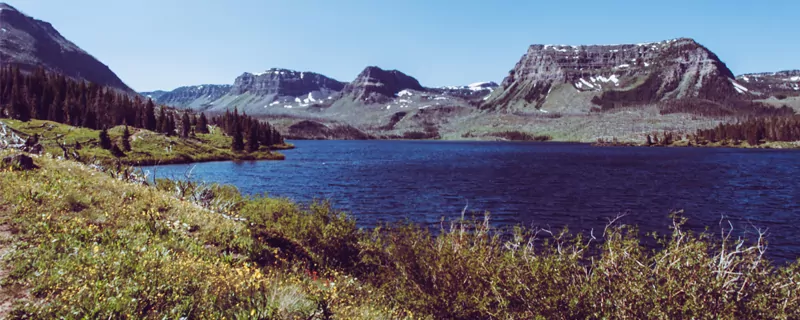
Trapper’s Lake bears the nickname “the Cradle of Wilderness” because it was there that the ideas which led to the Wilderness Act were first kindled.
Arthur Carhart, a recreation engineer for the forest service, was sent to survey Trapper’s Lake. He was to map out a plan for a marina, a road around the lake, and 100 homes. Immensely touched by the scenery, Carhart returned to his superiors and convinced them that they should abandon the project and set aside the land for protection. After convincing his superiors, he continued to lobby for the creation of protected areas in the National Forest System. His passionate writings and outcries eventually led to the Wilderness Act of 1964. The essential premise is that places should exist where no machine of man’s invention and no roads or other intrusions mar the pristine nature of the area.
Today, you’ll find designated campgrounds near Trapper’s Lake, but you won’t find a road to or around the lake itself. Surrounded by a ghost forest (the result of bark beetle infestation and devastating fire), it is a somewhat otherworldly place – especially on a full moon. Sheer volcanic cliffs rise to lofty heights, surrounding the shoreline and adding to the lake’s rugged, yet lush scenery.
Trapper’s Lake is a fantastic starting point for any backpacking adventure into the Flat Tops Wilderness.
Hike Flat Tops Wilderness with a Guide
Guided Flat Tops Wilderness backpacking trips are available and are a stress-free, exciting way to do this trip. The Flat Tops Explorer is an ideal choice for families. We use one breathtaking campsite for three nights, allowing us to explore on day hikes with only light day packs on Days 3 and 4. This hike follows a series of alpine lakes just below the treeline.
We establish our base camp near the shores of a pristine alpine lake where we camp for three nights. We keep our eyes peeled for wildlife, snap amazing photos, eat like royalty, and sleep under one of the clearest night skies ever seen! The tour company handles permits, gear, transportation, meals, and provides a professional guide so you can focus 100% on enjoying your adventure.
Activities
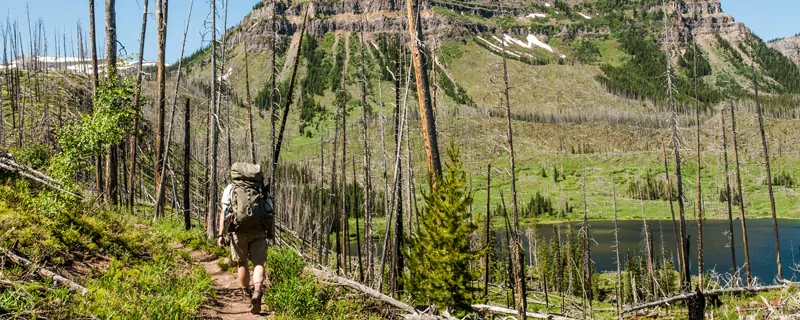
Backpacking is perhaps the best way to spend your time in the Flat Tops. Allowing you time to properly explore the area and take in its treasures, it also affords a wonderful night sky sleeping 11000′ feet closer to the stars.
Because of its Wilderness designation, no motorized vehicles or mechanical devices (e.g. mountain bikes or boat carts) are allowed within the wilderness boundary. Therefore, hiking is the preferred way to experience the landscape. The terrain is challenging at times, and you may need to bring microspikes for snow in the higher elevations. Be sure to use caution in the snowpack. Due to the rolling terrain, it is sometimes hard to know where the “edge” of a snowdrift is, and areas are often undercut.
If you choose to hike to one of the 100 or so lakes in the Flat Tops, be sure to pack a fishing pole. The area is popular with anglers and is home to the native cutthroat trout. As this Colorado fish’s numbers are dwindling, it is a catch and release policy for cutthroat caught within the wilderness boundary.
However you choose to spend your time in this pristine wilderness, you will no doubt be touched by its beauty.
Hike Flat Tops Wilderness with a Guide
Guided Flat Tops backpacking trips are available and are a stress-free, exciting way to do this trip. We offer two Flat Tops backpacking trips, including the four-day Chinese Wall Trek which ascends the incredible South Fork of the White River. We’ll traverse the verdant meadows along the massive Flat Tops Plateau and camp by high mountain lakes and streams.
Wildland Trekking Hiking Adventures
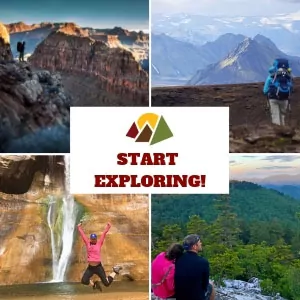
As the world’s premier hiking and trekking company, Wildland believes in connecting people to fantastic environments in amazing ways. Flat Tops Wilderness offers an array of incredible hiking and trekking experiences. Wildland Trekking provides 2 different multi-day hiking and backpacking adventures in the Flat Tops. Read more about our Colorado backpacking trips.
To learn more about our guided backpacking trips and all of our award-winning hiking vacations, please visit our website or connect with one of our Adventure Consultants: 800-715-HIKE




